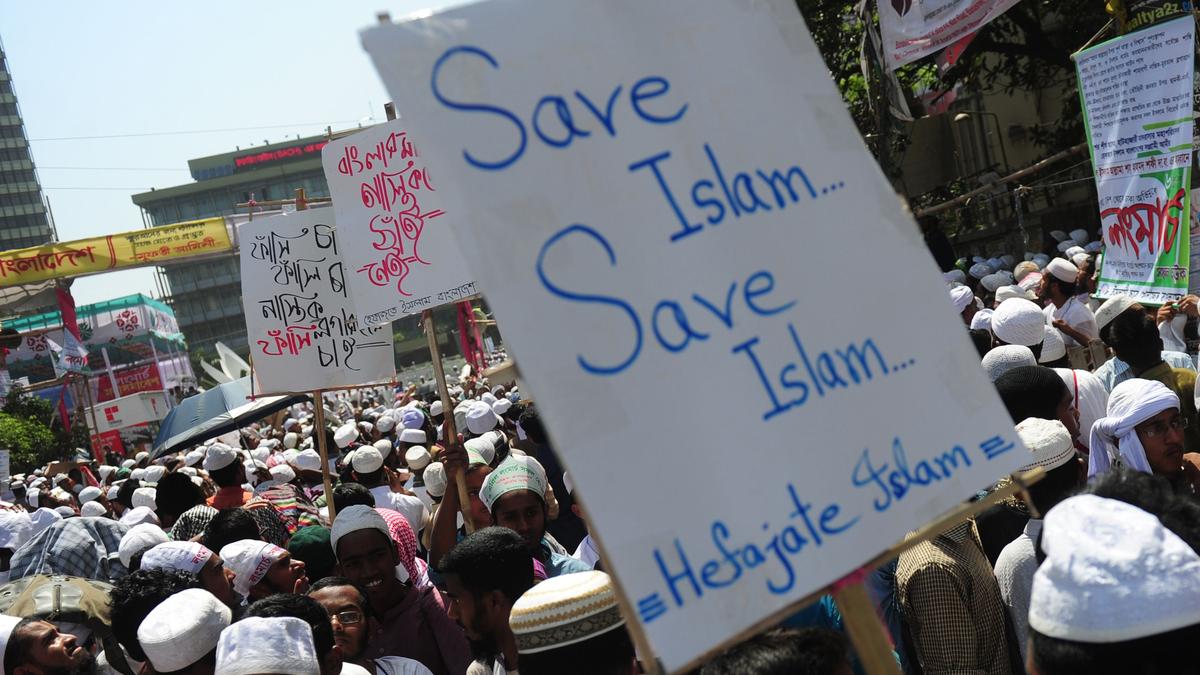The Hefazat-e-Islam has carried out multiple rallies in Bangladesh including a protest against Narendra Modi’s visit in 2021.
| Photo Credit: AFP
In the absence of the ‘Begums’ in ruling Bangladesh, Islamists have staked claim to the nation’s polity once again. Just like Bangladesh’s former Prime Minister Sheikh Hasina who attempted to placate hardliner outfit Hefazat-e-Islam, leader of the caretaker government Muhammad Yunus too has adopted a similar approach by inducting the extremist group’s deputy chief Prof. A.F.M. Khalid Hossain as Adviser for Religious Affairs in the interim government.
Hefazat-e-Islam, which translates to ‘Protectors of Islam’, was formed in 2010 to oppose the Sheikh Hasina government’s Women’s development policy which promised equal rights to property for women. Comprising mainly of Sunni clerics heading a network of 19,199 Quami madrassas and its students in Bangladesh, Hefazat rose to prominence as they took to the streets against the Women’s Bill. The group also protested against the repeal of the Fifth Amendment which had altered the Constitution’s secular, socialist nature during the military rule. The demonstrations, in which dozens were injured in clashes with the police, eventually resulted in the passage of a watered-down Women’s Bill.
Founded by Islamic scholar Shah Ahmad Shafi, the group initially started off as a ‘purely religious’ outfit with an aim to restore an Islamic administration in Bangladesh. Its current amir (chief) is Muhibbullah Babunagari who heads the central committee comprising several Maulanas. Most of the committee members were incarcerated in 2021 for staging violent protests against Narendra Modi’s visit to Dhaka. According to a 2017 Economist report, Hefazat’s madarassas are funded by Salafi-Wahabi Islamists in Saudi Arabia.
OPINION | Instability and uncertainty stalk Bangladesh
Hasina’s soft stance and anti-Modi protests
Emboldened by its initial display of street power, Hefazat launched a ‘long march’ to Dhaka in 2013 demanding capital punishment against ‘atheist’ bloggers involved in the Shahbag protests who had allegedly ‘insulted Islam’ in their posts. Through a series of massive rallies in Dhaka, the extremist group rolled out its 13-point agenda which demanded a stricter dress code as per Islam, a ban on statues, candlelit vigils, women’s development policy, public mixing of men and women and to declare Ahmadiyas as ‘non-Muslims’. Violent clashes broke out between the Islamist protestors and security forces as Hefazat attempted to ‘lay siege to Dhaka’, killing at least fifty.
Despite its extremist policies and involvement in clashes, the Sheikh Hasina government chose to indulge Hefazat. Ms. Hasina’s decision to remove the statue of the Greek Goddess Themis from the premises of the Supreme Court in 2017, recognising Dawra–e–Hadith (a master’s degree equivalent offered by the Quami madarssas) in 2018, and altering history texts are proof of her choice to appease the fundamentalists for their continued support. The reason, perhaps was the fact that Hefazat, which is a lesser militant version of the Jamaat-e-Islami, fundamentally differs from the Jamaat in its support for Bangladesh’s independence from Pakistan and opposition towards the 1975 massacre of Ms. Hasina’s family.
After its successes, Hefazat launched its biggest protest in 2021 when Mr. Modi visited Dhaka marking the nation’s 50th Independence Day. Accusing Mr. Modi of anti-Muslim riots in Gujarat in 2002, Hefazat, along with several other Islamist bodies, launched anti-Modi protests clashing with the police, resulting in at least 13 deaths. Several Hindu temples were also targeted and a train was attacked in Brahmanbaria.
Upon Mr. Modi’s departure from Dhaka, the Sheikh Hasina government cracked down on Hefazat, arresting hundreds of its members including 23 of its top leaders such as Mamunul Haque, Harunur Rashid and Monir Hossain Qasemi. As Hefazat began reorganising and reforming, Ms. Hasina once again indulged the group by promising to ‘look into its more reasonable demands’ in 2022. Most of the incarcerated leaders except Mr. Haque and Mr. Qasemi were granted bail in 2023.
Bigger ally
Following Ms.Hasina’s olive branch to Hefazat and her abrupt departure, Islamists have found an even bigger ally in Bangladesh’s chief adviser Muhammad Yunus.
The Yunus government has lifted the ban on Jamaat-e-Islami and granted bail to Jashimuddin Rahmani, the chief of the al-Qaeda-inspired terror group Ansarullah Bangla. Moreover, Mr. Yunus also met Mr. Haque, who had spearheaded Hefazat’s 2021 anti-Modi protests, raising alarms in India. Amid reports of multiple attacks on Hindus and vandalism of temples and houses, Mr. Yunus has downplayed it saying they were not communal, but a fallout of a political upheaval due to the community’s supposed support for the Hasina government – marking Bangladesh’s dark return to a hardline Islamist regime.
Published – September 15, 2024 01:46 am IST
